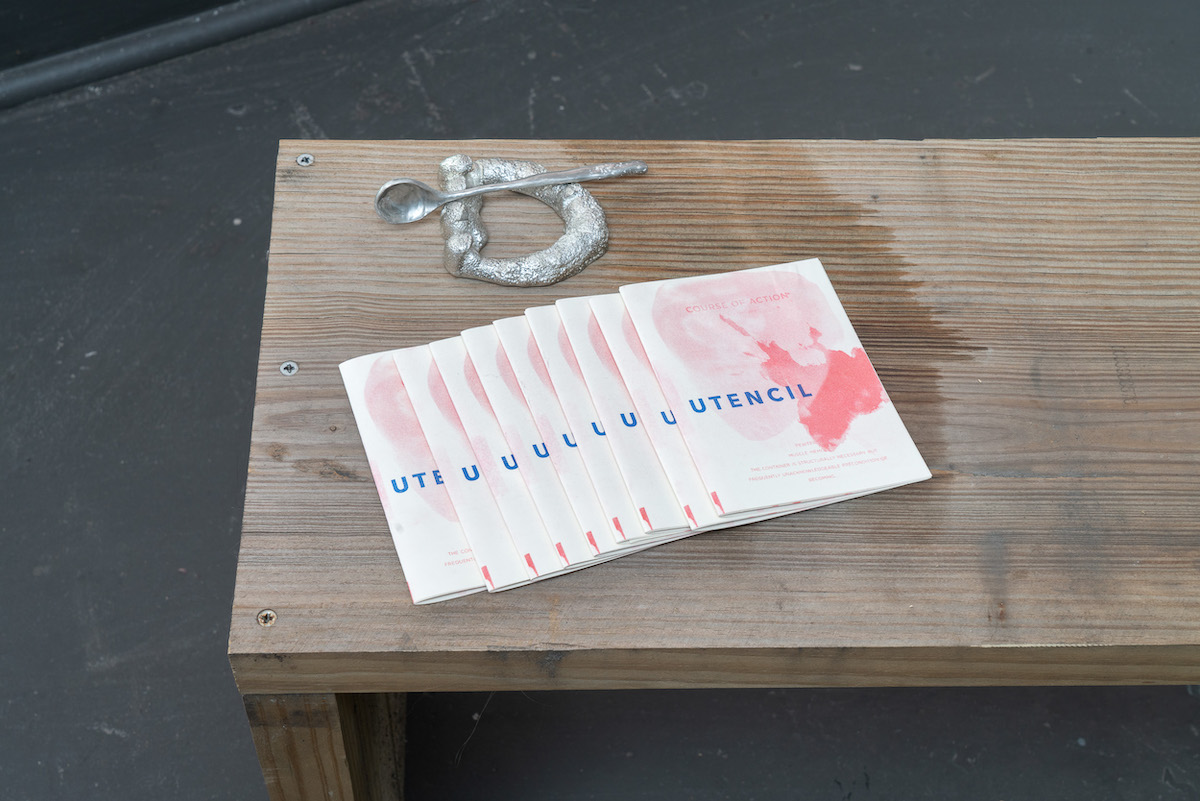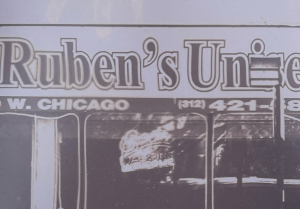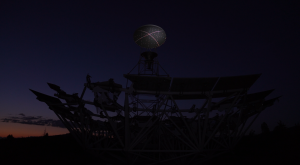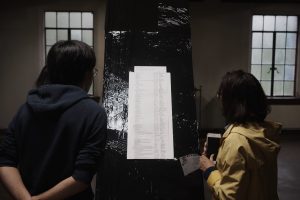Featured image: A stack of cream and pink-colored zines lay out on a wooden surface. The zines say “UTENSIL” on the covers. A pewter piece led by Maggie Wong and created by Maggie Wong and Alden Burke sits next to the stack of zines. One part of the sculpture is in the shape of a “D” and the other looks like a spoon. Image courtesy of Annas.
My dear reader, you are personally invited. The details of the event, the place you’ll arrive, the day on the calendar it will fall, it does not matter. The invitation itself is a radical outpouring of love extended towards you. I am demonstrating a collection of prompts for you to hold behind your eyes, chew with your teeth, and spit out on the sidewalk. UTENSIL, an exhibition presented by Annas at Comfort Station will serve as our overarching prompt, whom we can periodically retreat to as a home. UTENSIL is a continuation of the collective and prompted efforts of Alden Burke, Caroline Dahlberg, Mariel Harari, and Maggie Wong, with support from Azalea Henderson and Stephanie Koch.
Before we enter the doors of Comfort Station, let’s cleanse the palettes of our day, and ground ourselves in a collective consideration of what a prompt is:
“A prompt is an invitation to ease into entanglements, a generous permission to act, a container to explore a stretch in thought, a resurrected memory.
A prompt is an instruction. A prompt as a transition, bringing us to another space, another other, another self. A prompt as a thought experiment, as sensorial vibrancy, as a meeting of the unexpected. A stretch in thought, the resurrected memory. A prompt also asks: What is at stake, what tools are needed for vulnerability?
A prompt can move us. Find a utensil—trace the lengths of your arms; ask someone to trace the length of your arms; ask if you can trace the length of theirs; offer to trace them into the sky; ask if they might do the same for you.
A prompt contains self-reflection. Always around the corner is a world of people outside with which to build our collaboration. In becoming research, when we build from prompts, when we work from our conditions, how do we share and reperform with an audience? What are the limits?” -Annas.
With this knowledge, we can begin our journey through the walls of the gallery. True to the title of the exhibition, the room is permeated with utensils of various shapes, material, and form. Pewter tools ranging from recognizable spoon-like instruments to organic, abstract archways delicately balance amongst one another. Wooden shelves emerge from the walls in various heights to support and display these curious forms. Though small in stature, the pewter material of these sculptures signifies a weighted presence, as if lifting one of these palm-sized forms could cause your hand to buckle under their gravity. In material opposition are soft sculptures of utensils, warmly dispersed, begging to be squished. These pillows are oversized, but their doughy structure offers visual weightlessness. Anchored around the gallery walls and floors are thoughtful uses of text. These moments of floating language are combined with sculpture. In one corner sits a form reminiscent of the whites of a cracked egg. Beneath the sculpture, “re” is where the yolk would be, and “(arrange)” sits just outside the white. This tender overlap of sculpture and text, intentionally placed and considered, sets the tone for how we are to view the integration of language prompts and the physical artwork present: as equals, nurturing one another, becoming one another.
The concepts of world building, knowledge sharing, and prompting is integral to this exhibition well outside the constraints of the gallery walls. Annas included programming that allowed for physical explorations of these notions, including the invitation to eat cream of mushroom soup with the cohort in tangent with the exhibition closing. In an attempt to maintain this generated momentum within the fibers of this writing, I have invited the creatives behind UTENSIL to answer either, both, or none of two prompts that were circulating my mind while I viewed the exhibition.
* * *
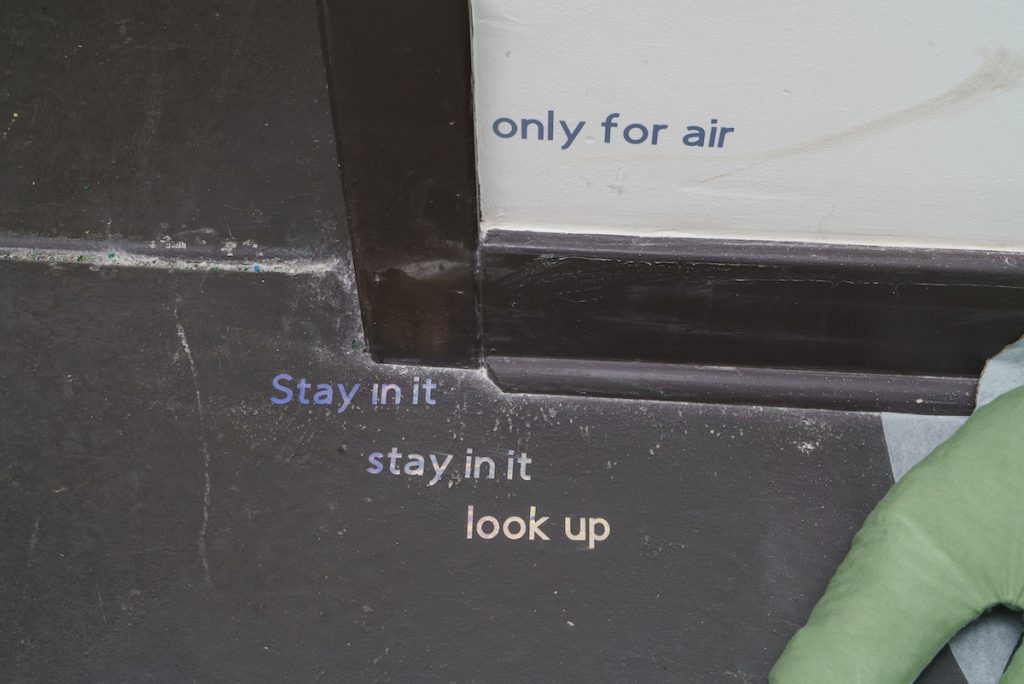
(prompt one) Reflect on a piece/contribution that you made for this exhibition: How does it feel in your hand? What would it taste like? If it’s an object you contributed, how much does it weigh using a relative other object and not a numerical value? If it’s an idea you contributed: what does the space it holds in your head look like?
(prompt two) Reflect on the world you built for each other over the course of planning this exhibition: What does it feel like when you share a part of your world with another? What is the texture of the feeling when someone uses your advice and lived experience to positively change their viewpoints? Where in your body does it hurt when someone uses these against you instead?
Curator, writer, facilitator, and Annas’ cofounder, Stephanie Koch (prompt one): “On a quick glance, I contributed the concept of prompts that frame the exhibition. I couldn’t join the cohort at Poor Farm in August 2021 so Alden encouraged me to think of a different kind of participation. I wrote a prompt every morning for the cohort at the same time during their stay:
Good morning lovies,
It’s 9:30 AM in the beautiful timezone that is Central Standard Time.
Find a quiet place you like and whichever surface you like to write on/with—outside in a lawn chair, on a comfy sofa, at a kitchen table; in a notebook, in your iPhone notes, on a scrap piece of paper.
Journal for 15 minutes in response to the below prompt. It’s free flow, and no need to worry about mistakes or “getting it right.” Feel free to keep to yourself or email to this chain for all, the choice is yours. The intention of this exercise is to ground yourself before starting your day.
The idea came from a therapeutic technique of journaling every day when you wake up to let unprocessed emotions emerge. My thought was the cohort hasn’t gathered in a while, they maybe haven’t made work since the pandemic began, they may have a lot of emotions and feelings about themselves or (inter)personal relationships outside of art-making. A moment to ground oneself and understand their emotional state before they enter into collaborative work felt like an important contribution since I couldn’t physically be there.
The cohort kept the practice of offering prompts after Poor Farm, and they incorporated prompts, this act of invitation, into the exhibition.
But although I incorporated prompts as a way to both give grounding and forward-moving energy into the exhibition, the work of prompts and response is a practice the cohort performed over and over in 2019. I incorporated an idea and way of working that they brought forth in a previous collaboration to see what new pathways would emerge.”
Stephanie Koch (prompt two): “To say sharing part of your world with another feels vulnerable would be understating the feeling. It’s not only vulnerable to share your ideas, as unformed and messy as they might be. It’s vulnerable to share and trust that someone will respond. Either with ideas in-kind, with support.
I can’t say I know what it feels like when something you offer to the world is taken into consideration and shift one’s way of thinking. I don’t know if I’ve worked long enough to see those shifts. I think what I have experienced is my ability to see and understand others viewpoints and weave them together to create a more complex and rich experience/story. That fabric’s texture is knotty, rough, worn, unpatterned, but feels warm and comforting. Something that can be worn again and again and feels just as supportive each time, but responds to what you need and offers a new support each time you wrap it around your shoulders.
Hmm, it’s interesting that I thought of shoulders; when the support goes away, I feel it in my shoulders. The left shoulder to be specific. A bodywork specialist actually shared a theory. That the right arm is used to swing your sword and the left is used to hold your shield. When I have stress in my left shoulder, it’s emotion burying itself in the fascia. The feeling of having to overprotect myself when I don’t feel support or when I’m about to dive into a vulnerable endeavor.”
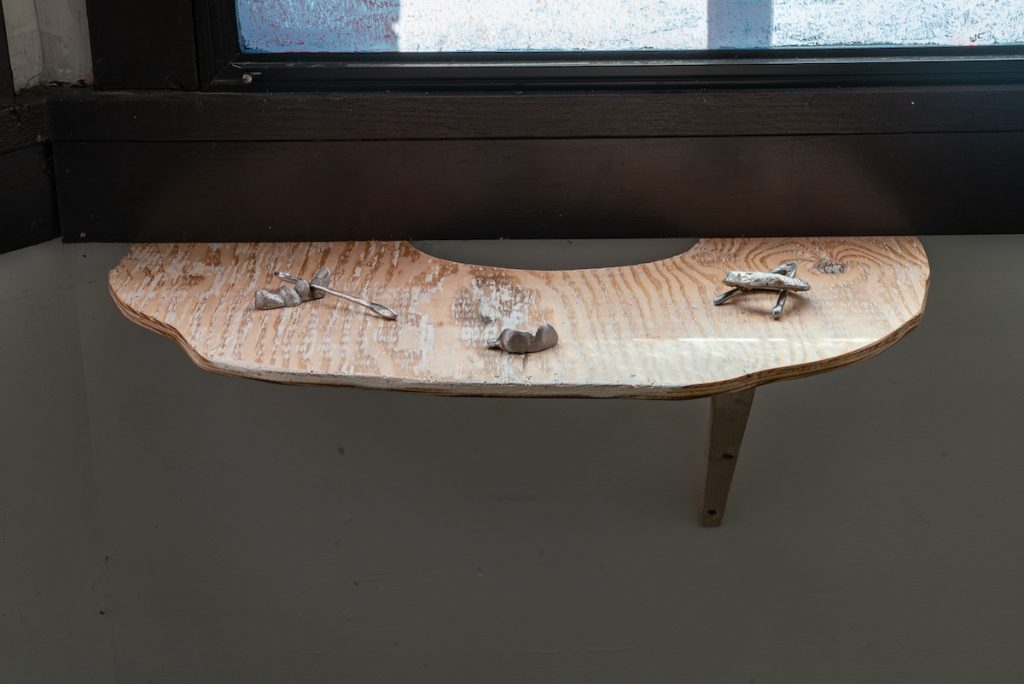
Artist and Annas resident, Mariel Harari (prompt one):

Mariel Harari (prompt two):
We are
All standing just slightly apart
Encased in a viscous substance
(Or maybe a wrap or just silly putty)
Between us is the physical manifestation of stretch
A free fall met with open hands
Trust and remembering to trust/the trust and continual reminders of trust and play and holding
Laughter fills (fuels?)focus
When we began reengaging we started remembering moving closer together
Some moments of gentle awkwardness as we reengaged muscle memory and generated new tissue
(Think standing in a circle formation)
We are now standing closer together
When we reach up
Stretch back
We are stretching out (on our own) to a (new?) place(s) from a collaborative grounding
Coming from a foundation of trust (designed to enable (celebrate) play/curiosity/feeling/contained or tethered tangents) means there are baseline agreements (acceptances) of both group and autonomous exploration sprinkled with many exclamations of Oohh yes YES! And then..!! And or also!
An excited hand jolting out of my chest in the happiest of ways!
In the space/language/logic we have formed there are certainly moments of (ultimately generative or smoothed) friction but no maliciousness of anything used against another- perhaps the most comparable for me would be the gritty (damp sand clumping in your shoulders/chest/forehead) texture of fear resulting from waiting-
fear produced by procrastinating sharing
Letting excitement build for an idea/process but putting off the feeling of vulnerability that comes with introducing it to any others
(perhaps due to temporarily forgetting the comfort in these others?)
But of course once introduced the damp clumps of sand dissipate —> moisture evaporates until the sand is sparkling dry and pours out ready: met with acceptance/ approval/ excitement/ conversation/ building/ thoughtful questioning/ offered alternatives/ ooh or how abouts/ yes and, yes and!
Remaining dynamic/cyclical/mycelial means there are no hard stops
we keep different paces at different points.
we accommodate different paces/needs/capacities throughout
open interpretation of communication becomes spaces between clarity, becomes structures of opportunity
Setting flexible rhythms of shared practice, splitting off to produce in personal modes of working, touching base, resting, regrouping, re arranging,
Points of marinating, jumping off, considering, more growth.
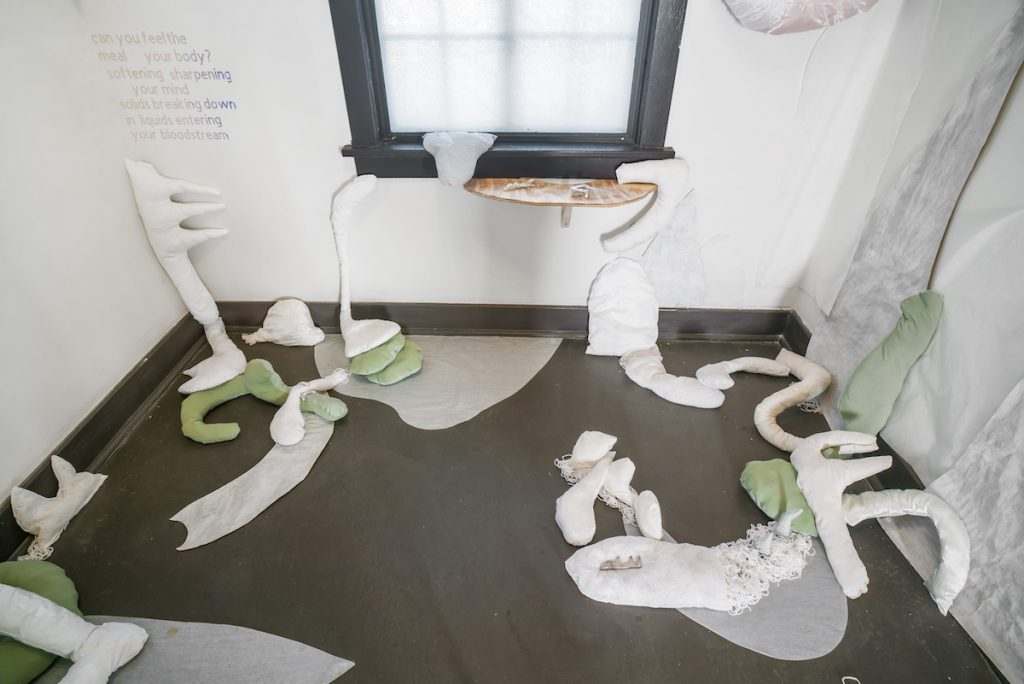
Artist, writer, and mentor, Maggie Wong (prompt one): “There is no logical place for this smooth but not polished shape in my hand. It is neither large enough to fit my hand through nor small enough to rest neatly in my palm. I can try though. I gather my fingers together to make a tapered-shaped hand and slip it through until the hard metal reaches the tickets part of my cone hand. It feels like a pantomimed version of a ring stacking toy. When I try to fit the circle in my hand, to grasp it, the outer edges peek out past the edges of my palm. I can feel its fullness and slight weight articulated at my knuckles and the heel of my hand, leaving the centermost sensitive part of my palm to expose a greater sense of air.
I will try and taste it soon. But I imagine it would not be a pleasant taste. Metallic is the obvious answer. But because of that fact, I imagine the piece to taste better when warm. My tongue could hook the ring and try to use all flavor senses to ascertain any complexity for the thing. But more than taste, the hard mouthfeel would dominate, and, like when holding the O phonetic tone, the mouth muscles would clench to hold shape. The undertones would be whatever biome decided to hang on to its surface.
If it’s an object you contributed, how much does it weigh using a relative other object and not a numerical value?
o = a small cup of water
I forget where the idea of using prompts came from, but there is a particular resonance to my life as an educator. I use prompts on a daily basis when teaching. Prompts for writing prompts for making, prompts for speaking and sharing with others. I read other teachers’ prompts, trying to peer into where they are leading their students. A prompt can bring a participant or student into a particularly restrictive or open creative form of thinking. The way a student is positioned to think or act all depends on what kind of pedagogy the prompt instrumentalizes. For example, a prompt in transmissive pedagogy looks like a strict course of action aimed to hardwire knowledge built from an ideology – memorize the countries of Africa and their capitals. On the other hand, a constructivist pedagogy would prompt an understanding about Africa in a very different fashion – Research a particular culture in Africa then create a map with your pears that shows your research. The ladder example is open to making new connections and running up against the political map, allowing for questions about communities, land use, colonization, and power to emerge. In the first example, there is no room for questions nor the invitation for criticality. What is at stake when you position a prompt is access to an ability for sensing and understanding the interdependence of what they are learning and how they are learning it. In essence, what is at stake is one ability to practice reality checks.
So where is this held in my head? It is held in memory from the teachers that have encouraged my curiosity, sense of wonder, and persistent analysis. It’s in a place of gratitude to them and remembering the moments where someone has held space for me to feel uncomfortable within the process of discovery.”
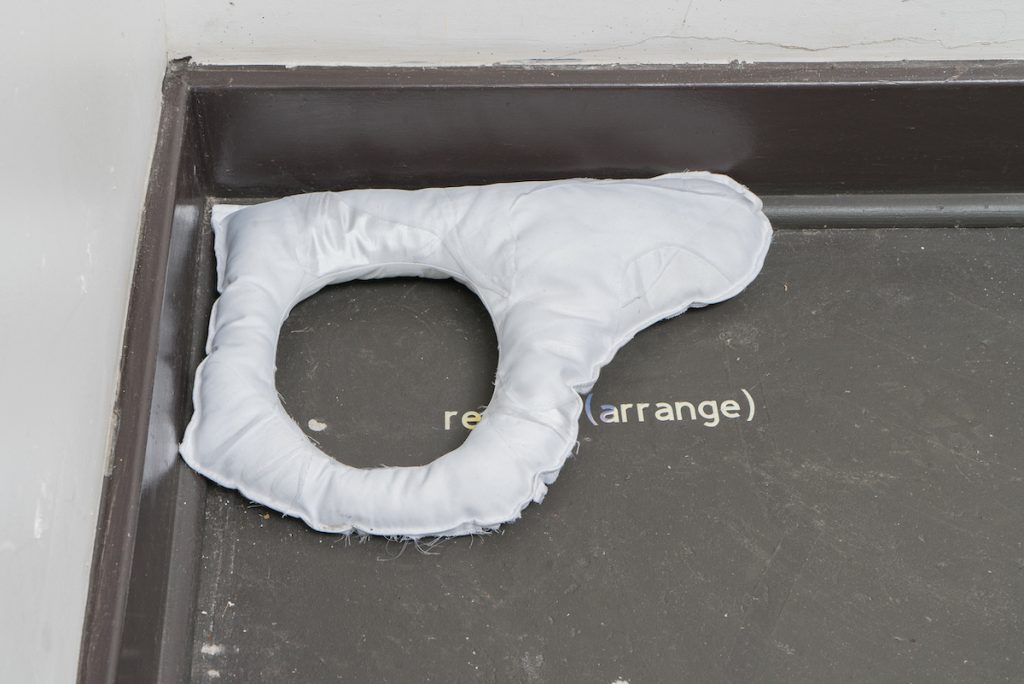
Educator, facilitator, and writer, Alden Burke: “What we write to you is not for reading — it is for being and becoming.”
“What enables a process of transformation?
(is this a form of poetry?)
H O O O L D
H O O O O L D
Text across the page in red then blue; a prompt spoken aloud; a self-determined act; a group-determined course of actions; a tool or utensil; a surprising tool or utensil; a space to pause–the stomach and all that is guttural.
Interlace your fingers and bring your hands towards your chest. Press your hands together as firmly as you can. As you begin to release the tension, pull your hours outwards, slowly entanglement your fingers. As your hands loosen, continue moving them in an outward trajectory, palms down and fingers outstretched ro skim the invisible surface of the ground.
As your hands move from a state of tension to one of presence, say the following:
DEEEcommmmPOSSsssiiiinnnggggg g g g g g g g g
U t e n s i l is the inevitable extension of our individual and collective time, knowledge, proclivities, and intimacies. The soil of our world-in-becoming is the boundaries of knowledge and intimacy between makers.
a hypothesis:
Sharing meals is foundational to our relationships
Our relationships are foundational to our trust
Our trust in one another is foundational to making work together
a hypothesis:
play as methodology!
prompts as a way to play out research!
Impress yourself into sky: feel yourself in the impression
Impress yourself into the ground: feel yourself in the impression
- Impress yourself into your body: feel yourself in the impression
- Impress these impression into another who is open to it:
feel where you meet
Our world is one of invitation, a place where intuitive and intentional collaboration is made manifest. Annas and Comfort Station are the testing ground for our methodology-of-becoming shared outwards. What we build together and offer up is both the tool and container in which “meaning circulates through organism/environment in the form of transformation, translations, and transmutations of difference.”
As a nod to the cyclical nature of sharing knowledge and world building, I was graciously welcomed in to take part of the group’s prompt exchange ritual. I received my invite on a Monday morning, at 9:30am, from exhibition member Maggie Wong:
“Good morning dears,
It’s 9:30 AM in the beautiful timezone that is Central Standard Time.
Find a quiet place you like and whichever surface you like to write on/with — outside in a lawn chair, on a comfy sofa, at a kitchen table; in a notebook, captured with your iPhone, on a scrap piece of paper.
Journal for 15 minutes in response to the below prompt. It’s free flow, and no need to worry about mistakes or “getting it right.” Feel free to keep to yourself or email to this chain for all, the choice is yours. The intention of this exercise is to ground yourself before starting your day.
What currents do you feel a part of today? Are you feeling like a strand in a braid of time? What wraps around you and in what time signature?
love,
Maggie”
* * *
I prepare for the writing session by lining up my morning utensils: my favorite pen, the one with the gentle stroke, like writing along the skin of a peach, and my designated oatmeal spoon, light and efficient. I set the clock for 15 minutes, and I begin to write. What I wrote, on what surface, and for what audience, it does not matter. The invitation itself was the radical outpouring of love extended towards me.

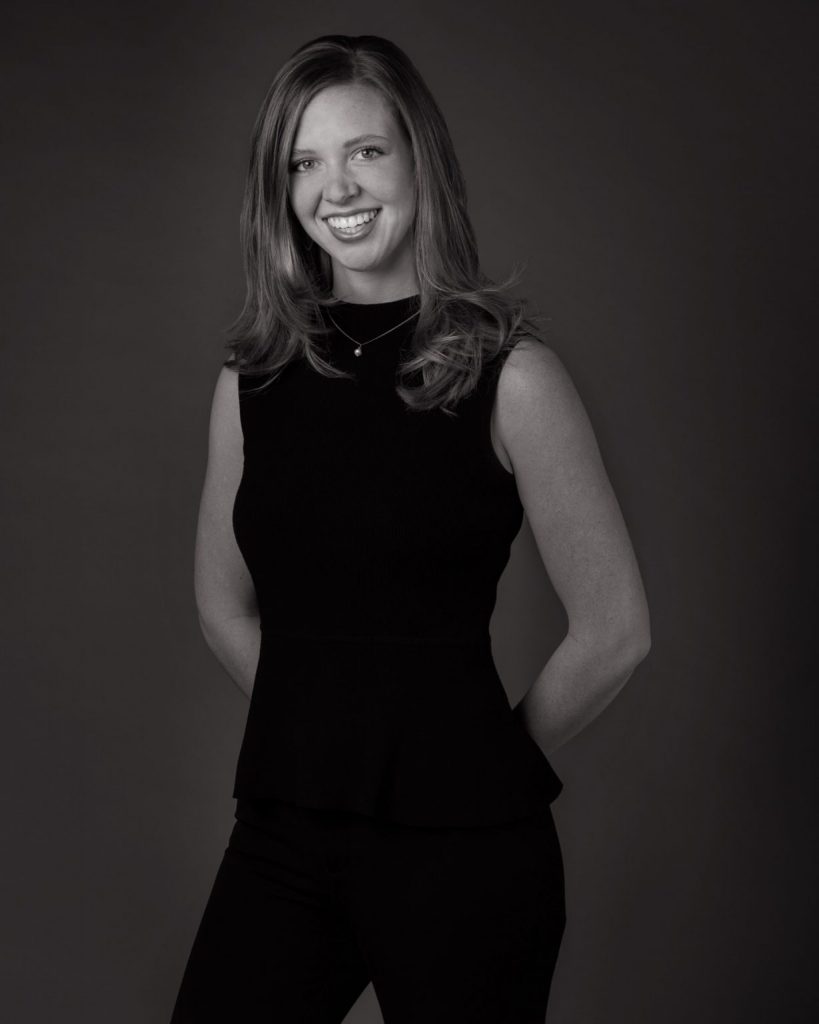
Ally Fouts is an artist, designer, and writer living in Chicago. She holds a Bachelor of Fine Arts in Art, Media, and Design from DePaul University. More information surrounding her artistic practice can be found on her website.
